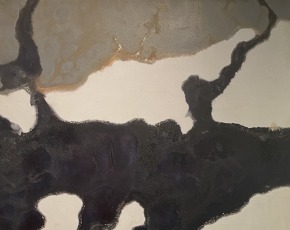
Scroll Down for More
#33 (1957)
Poured oil enamel on canvas, 51 ¼" x 42 ½" (frame 51 ¾" x 43")
Signed verso "Stanley Twardowicz" on canvas. Inscribed on canvas with title and date: "#33 – 1957" verso.
Exhibitions: 1958 Peridot Gallery, New York City (label verso)
Signed "Stanley Twardowicz" verso.
Peridot Gallery label verso with original price.
Title and date "#33 - 1957" verso.
Verso
Stanley Twardowicz's poured enamel works of the mid-1950's came as the result of a confluence of inspirations stirred together in a perfect storm. After moving to NJ, he visited New York City frequently, and became a regular at the Cedar Tavern. He also rented a small cabin in Maine, and in 1953 invited fellow artist Kenzo Okada and his wife Kimi to visit. They introduced the artist to Zen philosophy, and while walking along the rocky shore of Maine, a he made a keystone observation which would change the course of his artistic life.
In 1987 Stanley Twardowicz was interviewed and videotaped for a documentary in association with his retrospective at The Emily Lowe Gallery at Hofstra University, Hempstead, NY. With regard to his breakthrough poured "Biomorphic Expressionist" work (begun in 1953 and mastered in late-1955), the artist shared the following insights:
“The biggest breakthrough for me was when I came back from Europe. I used to spend my summers in Maine. And instead of deriving my breakthrough from someone else...and because my paintings are very fluid...I used to walk along the rocky shores of Maine, the tide pools coming in, and all of a sudden you see a tide pool moving in...automatically it hit me 'Why can’t you do that with paint?'. Just letting it flow. Almost like a natural act.
Pollock of course did the drip paintings, and that was a natural act for him. But to me I had to be more organic. With larger shapes. Instead of being limited. Well, limited for me, the idea of just using the drip and gesture. Do I have to show the gesture, to be able to make a strong statement? A gutsy statement? After a while I got to the point where I said 'that’s not necessary'. Because it’s almost like the idea, how can I phrase it? Gesture to me was limited. Because you can see how it was done. You can see the gesture. I wanted to get to the stage, for instance, without any effort whatsoever, no texture, no brushwork - where nothing shows but the painting. That’s a challenge. You asked me earlier about being confronted by a challenge or a thing, and I’ll tell you that took me quite a while to overcome."
1955 was a pivotal year for Stanley Twardowicz, as he finally mastered the single-session "pouring" technique he had begun in 1953. By applying household oil enamels, sometimes thinned, to canvases laid flat on the ground, he was able to produce paintings with flowing yet discreet organic shapes. The summary visual experience of the artist's compositions is one of pleasing lyrical simplicity and unerring color sense, which belies the sophistication and complexity at their core.
These biomorphic expressionist poured works were so innovative and impressive that Twardowicz was awarded a Guggenheim Fellowship in 1956, and the Museum of Modern Art acquired one of these new paintings for its permanent collection. Over the next few years, six additional museums would follow suit by acquiring the artist's work (as would many other institutions in the decades that followed).
In 1957, the same year our work painting #33 was created, Twardowicz's artistic stature was acknowledged and solidified when his 1957 painting #17 was selected for the cover of Art in America: New Talent Annual 1958. The following year New York City's prestigious Peridot Gallery began a long-standing representation of the artist, and gave him his first of twelve annual one-man exhibitions. Painting #33 is likely from Twardowicz's first Peridot exhibition.
Twardowicz's poured enamel paintings are in numerous museum collections, and have been featured in articles on the artist, as well as in numerous shows.
